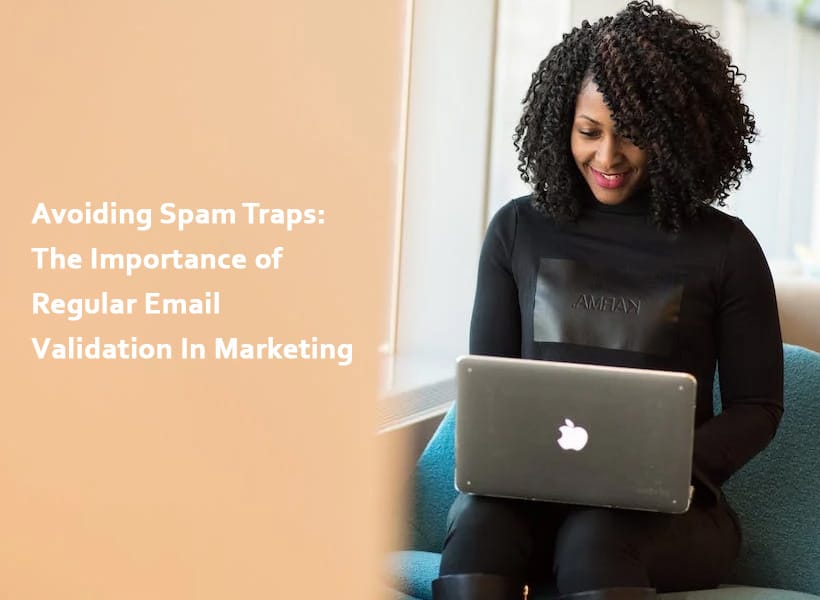Avoiding Spam Traps: The Importance of Regular Email Validation In Marketing

Internet service providers (ISPs) and anti-spam organizations use spam traps to detect and monitor spam emails.
These traps prevent spammers from reaching the recipient’s mailbox by blocking or rejecting them. Unfortunately, even legit emails often fall into these traps, hampering email deliverability and sender reputation.
And we all know high bounce rates can impact your marketing campaigns negatively. That’s where email validation can help in avoiding spam traps altogether. Keep reading to learn the importance of regular email validation in marketing.
Types Of Spam Traps
-
Pristine Spam Traps
Pristine spam traps are email addresses available on public websites. Those using illegitimate ways to scrape web pages and buy email addresses from questionable sources end up with pristine spam traps on their list. And sending emails to pristine spam traps is the quickest way your email address may get blocked and labeled as spam.
-
Recycled Spam Traps
Recycled spam traps are email addresses once used by individuals in the past before being abandoned. So, when you send emails to such email addresses, the service provider responds with a hard bounce before repurposing them into spam traps.
If you fail to keep your email list clean and notice the hard bounce, you will get trapped and flagged as a spammer.
-
Typo Spam Traps
These are email addresses that subscribers may have incorrectly typed. While this trap doesn’t necessarily mean you’re a spammer, it does represent carelessness when it comes to email list-building and cleaning.
-
Seeded spam traps
Seeded spam traps are email addresses that are created by ISPs or anti-trap organizations and placed on different websites, forums, and other online platforms. These traps aren’t visible to normal users but can be harvested using spambots. Sending emails to seeded spam traps indicates that you’re using illegitimate methods to acquire email IDs and can result in your emails being blocked or filtered.
-
Repurposed spam traps
Repurposed spam traps are email addresses that were once owned by real individuals but have been abandoned. ISPs and anti-spam organizations repurpose these addresses to catch senders who are not regularly cleaning their lists. Sending emails to repurposed spam traps shows that you’re not maintaining your list hygiene and can result in your emails being blocked or filtered.
How Does Regular Email Validation Avoid Spam Traps
A clean and responsive mailing list is always better than a long, unengaged list filled with spam traps. Moreover, validating your email list regularly is the best way to avoid getting flagged as spam.
-
Ensures List Cleanliness:
Email validation tools scan your email list to identify and remove invalid, inactive, or non-existent email addresses. By doing so, they eliminate the risk of sending emails to spam traps, such as pristine or recycled traps, which are often created from outdated or improperly maintained email lists. Keeping your list clean through regular validation reduces the likelihood of triggering spam filters and damaging your sender reputation, ultimately helping to improve email deliverability.
-
Identifies Risky Addresses:
Apart from invalid addresses, email validation tools also flag risky addresses, such as those associated with known spam domains or temporary email services. These addresses have a higher likelihood of being spam traps or belonging to recipients who are disinterested or unengaged. By identifying and removing these addresses from your list, you mitigate the risk of sending emails that could be flagged as spam. To help manage this process effectively, using an email verifier can ensure your list remains clean and reliable.
-
Detects Typos and Errors:
Typos and formatting errors in email addresses can inadvertently lead to spam traps. For example, a typo in a legitimate domain name might inadvertently match a spam trap domain. Email validation tools help detect and correct such errors, ensuring that emails are delivered to legitimate recipients rather than falling into traps designed to catch senders with poor list hygiene.
-
Improves Deliverability and Engagement:
By maintaining a clean and validated email list, you improve your email deliverability rates and enhance engagement with your audience. Emails are more likely to reach the intended recipients’ inboxes, leading to higher open and click-through rates. This not only enhances the effectiveness of your marketing campaigns but also reduces the risk of being flagged as a spammer by ISPs and anti-spam organizations.
Does regular email validation save on costs or improve profits?
While specific figures on profit made or money saved through regular email validation can vary depending on factors such as email list size, industry, and campaign objectives, there are some general insights and statistics available that do show an increase in revenue. According to a study done by the Data & Marketing Association (DMA), email marketing has an impressive return on investment (ROI) for $42 for every $1 spent.
Email validation automation streamlines the process of maintaining list hygiene and ensures that marketers can focus on creating compelling content and strategic campaign planning. By leveraging email validation tools and services, businesses can save time and resources that would otherwise be spent manually cleaning and managing their lists. Increased email efficiency translates to higher productivity, faster campaign deployment, and better performance overall.
So, you can understand that regular email validation does have a tremendous impact on how much money you make through your campaigns.
Final Words
Avoiding spam traps isn’t rocket science, provided you install an email validation API to work in real time. It will block fake sign-ups and bots to boost your marketing campaign with better deliverability.
And your mailing list will be free from invalid or non-existent email addresses, which might be on the verge of being recycled as a spam trap.
That said, even legitimate and respected email senders may occasionally fall into a spam trap. So, be cautious and avoid buying email lists from untrustworthy sources. Also, make sure to remove dormant subscribers every three months and use a double opt-in sign-up method to reduce the number of fake sign-ups.
These pointers will help you maximize ROI on your email marketing campaign.

